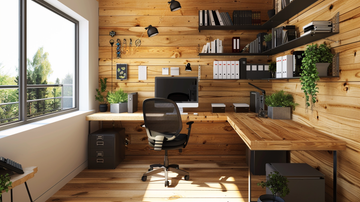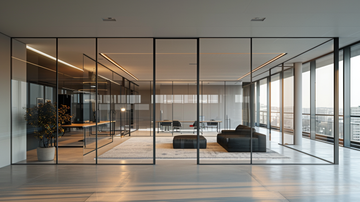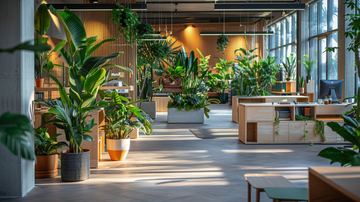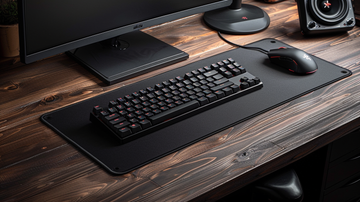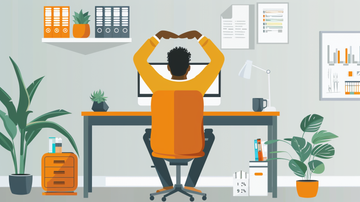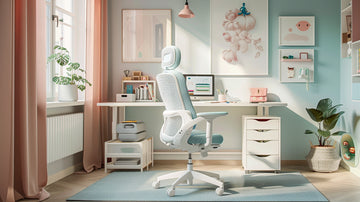Introduction: The Rise of the Home Office
The COVID-19 pandemic has ushered in a new era of remote work, transforming the traditional office landscape. According to a Pew Research Center survey, about a third of U.S. workers who can work from home are now doing so full-time. This shift has necessitated the creation of dedicated home office spaces that not only facilitate productivity but also inspire creativity.
In a world where innovation and out-of-the-box thinking are highly valued, the design of a home office plays a crucial role in fostering a creative mindset. By carefully curating the environment, individuals can unlock their full potential and tap into their creative reserves, leading to breakthroughs and innovative solutions.
The Role of Design in Fostering Creativity
The physical environment in which we work plays a crucial role in shaping our creativity, productivity, and overall well-being. Numerous studies have demonstrated a direct correlation between our surroundings and our ability to think creatively and innovatively. Research has found that an individual's environment can significantly influence whether they are able to tap into their creative potential or remain stifled.
Thoughtful design is key to creating a space that inspires and nurtures creativity. By carefully considering elements such as color, lighting, organization, and ergonomics, we can craft a physical environment that not only supports but actively encourages creative thinking and problem-solving. The impact of a well-designed workspace should not be underestimated, as it can have a profound effect on our ability to generate new ideas, think outside the box, and approach challenges from fresh perspectives.
Choosing the Right Location
Selecting the ideal location for your home office is crucial for maximizing productivity and creativity. One of the primary considerations is natural light. Position your workspace near a window or glass door to benefit from the mood-boosting and energizing effects of sunlight. However, be mindful of glare and ensure adequate window coverings to control excessive brightness.
Noise levels are another essential factor. Opt for a quieter area of your home, away from high-traffic zones or external disturbances like street noise. If complete silence is challenging, consider incorporating white noise or ambient soundtracks to help you focus. Privacy is also vital, as frequent interruptions can disrupt your workflow. Choose a space with a door that can be closed or a dedicated room separate from the main living areas.
Other elements to consider include proximity to essentials like restrooms, kitchenettes, and power outlets. Ensure the space is large enough to accommodate your desk, storage, and any additional furniture or equipment you require. If possible, choose a location with a distinct entrance or separate access to maintain a clear boundary between your work and personal life. (Source: 9 Essential Home Office Design Tips)
Color Psychology and Its Impact
The colors we surround ourselves with have a profound impact on our mood, productivity, and creativity. According to research, certain hues can stimulate different emotions and cognitive processes. For instance, studies have found that blue is associated with calmness, focus, and stability, making it an excellent choice for tasks that require concentration and creative thinking (Source).
When designing a home office, it's essential to consider the psychological effects of color and use them strategically to create an environment that fosters creativity and inspiration. Warm tones like red and orange can energize and stimulate passion, while cool hues like green and blue can promote relaxation and clear thinking. A balanced color scheme that incorporates both warm and cool tones can help strike the perfect balance between motivation and tranquility.
Additionally, incorporating pops of color through accent walls, artwork, or accessories can add visual interest and serve as a source of inspiration. However, it's crucial to avoid overwhelming the space with too many bold or contrasting colors, as this can lead to overstimulation and distraction.
Maximizing Natural Light
Natural light is an invaluable asset for any workspace, including a home office. Exposure to daylight has been proven to boost productivity, improve mood, and promote overall well-being. According to a study published in 2017, workers in offices with natural light experienced an 84% drop in headaches, eyestrain, and blurred vision compared to those in offices without natural light.
To maximize natural light in your home office, strategically place your desk near windows or glass doors. If possible, position your workspace to face the window, allowing natural light to illuminate your work area directly. Additionally, consider using light-reflecting surfaces, such as mirrors or light-colored walls, to bounce and diffuse sunlight throughout the room. Sheer or translucent curtains can also help filter and soften harsh sunlight while preserving the benefits of natural illumination.
Incorporating Nature and Biophilic Design
Biophilic design, the concept of incorporating natural elements into built environments, can significantly enhance creativity and well-being in a home office. By bringing in plants, natural materials like wood, and nature-inspired patterns, you can create a space that feels more connected to the outdoors and taps into our innate affinity for nature.
According to SimpleDwelling.net, the principles of biophilic design include access to natural light and air, incorporating natural shapes and forms, using natural patterns and processes, and creating a sense of place and connection to the environment. These elements can help reduce stress, improve focus, and boost creativity.
Thermory.com suggests incorporating elements like potted plants, natural materials like wood or stone, and nature-inspired artwork or patterns to bring the outdoors in. Even something as simple as a view of nature through a window can have a calming and rejuvenating effect, making it easier to stay productive and inspired throughout the workday.
Organizing and Decluttering
A cluttered and disorganized workspace can be a significant barrier to productivity and creativity. Conversely, a well-organized and decluttered environment can foster a sense of calm, clarity, and inspiration. According to a study by WebMD, disorderly environments promote creativity and fresh thinking, while orderly spaces are more conducive to healthy choices and focus.
To create an inspiring and productive home office, it's essential to declutter and organize your space regularly. Start by removing any unnecessary items, papers, or clutter that may be distracting or overwhelming. Invest in storage solutions, such as shelves, cabinets, or organizers, to keep your workspace tidy and organized. Additionally, consider implementing a filing system or going paperless to minimize physical clutter.
Decluttering and organizing your home office can also have mental health benefits. Utah State University Extension notes that physical activity during the decluttering process can enhance creativity by allowing the mind to wander. Furthermore, a decluttered space can reduce stress and anxiety, promoting a more peaceful and focused work environment.
Personalization and Inspirational Elements
A home office should be a reflection of your personality and a source of motivation. Surround yourself with items that inspire and energize you. Incorporate artwork, photographs, or vision boards that resonate with your goals and aspirations. Display meaningful quotes or affirmations to keep you focused and driven. Consider adding personal mementos or objects that bring you joy and remind you of your passions.
According to Architectural Digest, "A home office should be a space that inspires you to create, innovate, and accomplish your goals." Personalization is key to achieving this, as it transforms a generic workspace into an environment that feels uniquely yours and fosters creativity.
Ergonomics and Comfort
Creating an ergonomic and comfortable workspace is crucial for maintaining physical well-being and productivity while working from home. Prolonged sitting and poor posture can lead to musculoskeletal issues, fatigue, and discomfort, hindering creativity and focus. To optimize your home office setup, consider investing in ergonomic furniture and accessories.
Start with an adjustable ergonomic chair that provides proper lumbar support and allows you to maintain a neutral spine alignment. An adjustable desk or desk riser can help you achieve the ideal desk height, ensuring your forearms are parallel to the floor and your wrists are in a neutral position when typing.
Additionally, incorporate ergonomic accessories like a wrist rest, an external keyboard and mouse, and a monitor arm or stand to position your screen at an appropriate eye level. Remember to take frequent breaks, stretch, and alternate between sitting and standing positions to combat fatigue and promote better circulation.
Multifunctional Spaces and Flexibility
In today's dynamic world, a home office often needs to serve multiple purposes beyond just a dedicated workspace. Embracing a multifunctional design approach can maximize the utility and flexibility of your home office. Consider incorporating a guest room, a creative studio, or even a reading nook into your home office design. This versatility allows you to adapt the space to your changing needs, whether you're hosting visitors, pursuing a creative hobby, or simply seeking a cozy spot to unwind.
Incorporating modular furniture, movable partitions, and clever storage solutions can help you transition seamlessly between different functionalities. For instance, a mid-century modern design with a sleek, minimalist aesthetic can provide both a stylish and functional workspace while allowing for easy reconfiguration when needed.
Tech and Smart Home Integration
In today's digital age, integrating smart home technology into your home office can significantly enhance productivity, efficiency, and even creativity. From voice-controlled assistants to automated lighting and climate control, these innovative solutions can streamline your workflow and create an environment conducive to focused and inspired work.
Consider incorporating a smart assistant like Amazon's Alexa or Google Home to handle tasks like setting reminders, managing your calendar, and even controlling other smart devices in your office. This hands-free convenience can help you stay organized and minimize distractions, allowing you to concentrate on your creative endeavors.
Smart lighting systems can also play a crucial role in setting the right ambiance for different tasks. Adjustable ambient lighting can help reduce eye strain and create a calming atmosphere, while dynamic lighting can energize and inspire you during brainstorming sessions or when you need an extra creative boost.
Furthermore, integrating smart climate control can ensure a comfortable and consistent temperature, which is essential for maintaining focus and productivity. Smart thermostats can learn your preferences and adjust the temperature accordingly, eliminating the need for constant manual adjustments.
Inspiring Home Office Examples
To spark your creativity and provide visual inspiration, let's explore some stunning home office designs that embody the principles we've discussed. From minimalist and modern to cozy and eclectic, these examples showcase how thoughtful design can transform a workspace into a haven for productivity and inspiration.
One standout example is a sleek, contemporary home office featured on Architectural Digest. With its clean lines, ample natural light, and seamless integration of greenery, this space exudes a sense of calm and focus. The minimalist aesthetic allows the mind to declutter, while the pops of color and carefully curated decor elements add personality and inspiration.
For those drawn to more traditional or eclectic styles, Houzz offers a wealth of inspiring home office designs. From cozy nooks tucked away in a corner to grand, library-inspired spaces, these examples demonstrate how to marry functionality with personal flair. Built-in shelving, plush seating, and unique lighting fixtures create inviting atmospheres that encourage creativity and productivity.
Conclusion: Unleashing Your Creativity
Creating a home office that inspires creativity and productivity is a worthwhile investment in your professional and personal growth. By thoughtfully considering the design elements outlined in this guide, you can transform your workspace into a haven that fosters inspiration, focus, and innovative thinking.
Remember, the key lies in finding the perfect balance between functionality and aesthetics. Incorporate colors that energize you, maximize natural light, and surround yourself with elements that spark joy and motivation. Embrace ergonomics for comfort, declutter for clarity, and personalize your space to reflect your unique personality and aspirations.
Don't be afraid to experiment and adapt your home office to your evolving needs. Embrace flexibility and multifunctionality to ensure your workspace remains a dynamic and ever-evolving creative haven. By implementing the tips and ideas shared in this guide, you'll be well on your way to unlocking your full creative potential and achieving remarkable success in your work-from-home endeavors.

